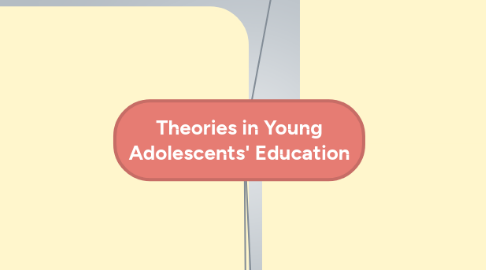
1. Development Theories (Personal, Social & Emotional)
1.1. Identity Development
1.1.1. Erikson believes that people fall under 8 stages of psychosocial development
1.1.2. Young adolescents fall under stage 4&5 of Erikson's stages of development. These are Industry vs. inferiority and identity vs. role confusion. Through these stages, young adolescents will have developed competence and fidelity and created a sense of identity.
1.1.3. A bad grade in the classroom may hurt a student's confidence, leading to a sense of inferiority. In this case, it is important that students do not have negative self-esteem so they may instead have a sense of competence.
1.1.4. Not being accepted into a certain friend group or clique can also lead a young adolescent to feelings of inferiority
1.2. Self Determination Theory
1.2.1. Competence is driven my a need or desire to grow and gain fulfillment.
1.2.2. Based on Autonomy, competence, and relatedness.
1.2.3. In a classroom, this would look like students performing without a reward system; they would find fulfillment in completing the task itself without external rewards. This relates back to the self-motivation theory and the intrinsic motives to learn.
1.2.4. Outside of the classroom could be seen in students who choose to volunteer for the fulfillment of doing something for a good cause, rather than receiving a tangible reward. Another example we discussed in class was exercise because exercise must be manifested by the individual themselves (see motivation theories).
2. Motivation Theories
2.1. Self Motivation:
2.1.1. Young adolescents must have a DESIRE to learn
2.1.2. Children should be empowered by teachers, but the teacher CANNOT create self-motivation in his or her students
2.1.3. Self-efficacy: Belief in the ability to change one's circumstance (see self-determination)
2.1.4. In my own teaching experience, I have found that students are more motivated on learning topics that they are interested. For instance, they displayed more motivation towards a historical biography project on Babe Ruth because they took an interest to sports history (also see goal theory: mastery goals)
2.1.5. Students carry this motivation outside the classroom to activities such as sports. Students are extremely disciplined in their own athletics because they have strong intrinsic motivation to become a better athlete
2.2. Attribution
2.2.1. What one attributes their success or failure to
2.2.2. Often, praise leads students to attribute their success to their teacher. Praise should be given based on effort, not outcomes, and recognize the effort that went in to the outcome.
2.2.3. Reasons people give for success or lack of success: task difficulty, luck, innate ability or talent, effort. Effort is the only rationale that is not an external factor.
2.2.3.1. Leads to fixed/growth mindsets & learned helplessness
2.2.4. Students may or may not pursue certain hobbies if they don't believe they have a natural ability to do so (artistic ability, athletic ability)
2.2.4.1. 10,000 hour rule
2.3. Goal Theory
2.3.1. Why people are motivated; why they set goals. Separated in 2 main categories.
2.3.2. Mastery goals: desire to achieve a goal because of a true interest and desire to learn.Example: A student Pursuing a topic not discussed in class because of a taken interest. For instance, a student hearing about ISIS attacks chooses to explore conflict in the Middle East
2.3.3. Performance goals: based heavily on competition or fear of failure. A strong desire to appear competent or above average to peers. This could extend to "clique groups" and relate to social development because of a need for acceptance in peer's eyes. Also seen in the classroom when students only work for the grade, not to pursue a specific interest.
3. Learning Theories
3.1. Vygotsky's Social Development Theory:
3.1.1. Belief that children learn through play and sensory experience
3.1.2. Social interaction is crucial and peers play an integral part in the learning experience. Games in the classroom are encouraged, especially when a peer can motivate a child to do well and scaffold. Group activities or group work is an example of this.
3.1.3. Zone of Proximal Development is a main component. Young adolescents should be pushed past what they can already do, but not pushed to the extent that a task is not feasible.
3.1.4. This can also carry over to life skills; Children learn life skills such as teamwork and manners from playing and interacting with others.
3.2. Piaget's Theory of Cognitive Development:
3.2.1. Piaget believed that children construct their own knowledge by giving meaning to people, places and other environmental interactions.
3.2.2. This theory has 4 main stages to Cognitive Development: Sensorimotor (birth-18 months), preoperational (18 months-6years), Concrete operational (6 years-12 years), and formal operational (12 years and older)
3.2.3. Young adolescents in middle grades will be somewhere within Concrete and formal operational. Some of your students may not be able to grasp a concept such as "time and space" because it is a more abstract idea and they are not cognitively developed in the formal operational stage.
3.2.4. Concrete operational stresses a reliance on tangible evidence for students' learning. Classrooms should incorporate manipulatives and models to foster learning at this stage.
3.2.5. At this stage, young adolescents are also beginning to initiate some of their own learning in other areas and form their own opinions in social settings. One such example could be an interest in politics and forming a political identity.
